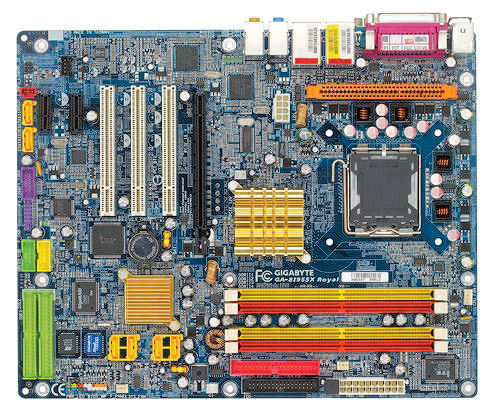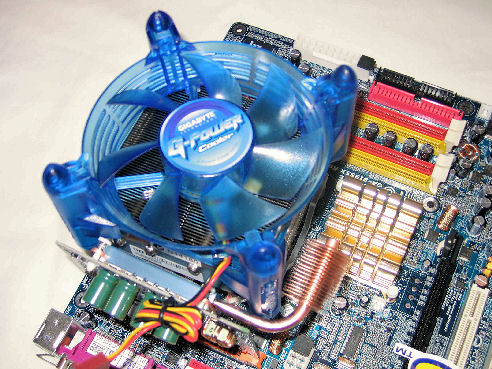Intel Motherboards: Can a Diamond beat a Royal Flush?
by Gary Key on September 23, 2005 12:05 AM EST- Posted in
- Motherboards
Gigabyte GA-8I955X Royal: Layout & Features
However, Gigabyte did get the DIMM module slots' color coordination correct for dual channel setup. The power plug placement favors standard ATX case design and the power cable management is very good. Gigabyte actually places the eight-pin 12v auxiliary power connector to the left of the CPU socket area, which should assist in easier installs for newer case designs that mount the power supply at the bottom of the case. In a standard ATX case design, there is the possibility of cable clutter around the CPU socket area.
The floppy and Intel ICH7R IDE connectors are conveniently located along the back of the board and allow usage of ribbon or rounded cables.
The Northbridge is passively cooled, but Gigabyte does provide their Cool Plus fan that should be used based on our overclock testing. However, upon installing the fan, it can interfere with a larger style heatsink. We did find the Northbridge heatsink to be slightly loose during testing and required additional pressure to lock in place. The Southbridge heatsink is a low profile design and will not interfere with longer cards.
The board comes with (1) PCI Express x16 slot that is followed by (3) 32bit PCI slots, and (2) PCI Express x1 slots. This design allows the use of larger video card coolers without blocking the PCI Express slots.
Unlike the MSI P4N Diamond, the CMOS reset is a traditional jumper design located between the first and second PCI slot that proved to be inconvenient at times.
The Intel ICH7R SATA ports are conveniently located to the bottom of the Southbridge and feature the new clamp and latch design. Gigabyte did include two of the new cable designs in their kit, which greatly enhanced the security of the SATA connections. The GigaRaid IT8212F IDE and Silicon Image 3132 SATA connectors are located to the far left of the CPU socket and could potentially cause cable clutter in a standard size ATX case and possibly create cable length issues in a full tower case.
Returning to the CPU socket area, we find an orange slot that holds Gigabyte's Universal Plus Dual Power System or U-Plus DPS for short. This card contains an eight-phase power circuit designed to improve the quality and stability of power to the CPU. The system will operate fine without it, but it was required for our overclocking results. The issue is this: once you install the card, it will block the installation of most cooling solutions and actually works as a barrier for proper airflow in the area. The most disappointing aspect is that Gigabyte produces excellent CPU coolers and as the image shows, their own G-Power unit will not work on this board.
Gigabyte ships their EasyTune 5.0 software package, which allows users to configure and adjust the front side bus speed, CPU multiplier (requires reboot), and change various system voltage settings. It will not allow real time changes to the CPU multiplier as this is only allowed within the BIOS. The utility will also allow you to monitor various system functions and provides the ability to control the CPU and North Bridge fans.
The GA-8I955X Royal includes the Realtek ALC 882M codec for on-board audio duties. The audio system boasts 24-bit 7.1+2 Channel audio featuring five 24-bit stereo DACs with a 103dB SNR rating and three 20-bit stereo ADCs DACs with 90dBA SNR rating. The 10 DAC channels support a 16/20/24-bit PCM format for 7.1 sound playback, plus 2 channels of independent stereo sound output (multiple streaming) through the Front-Out-Left and Front-Out-Right channels. The two 16/20/24-bit S/PDIF-OUT connections (coaxial/optical) support 44.1k/48k/96k/192kHz sample rates. The single 16/20/24-bit S/PDIF-IN connection supports 44.1k/48k/96k/192kHz sample rates. The audio system fully supports Intel's Azalia High Definition Audio standard and comes with an extensive and (as of this writing) exclusive Dolby Master Studio software package. However, as impressive as the Realtek ALC 882M specifications sound, it is a host audio solution and will consume significantly more CPU resources than the hardware based DSP solution on the MSI board.
Gigabyte also included a USB Bluetooth adapter. The dongle is very small and unobtrusive and works well with our Bluetooth-enabled cell phones. A USB extender cable is included for this adapter and has the standard USB connectors that make it useful for other USB devices.

However, Gigabyte did get the DIMM module slots' color coordination correct for dual channel setup. The power plug placement favors standard ATX case design and the power cable management is very good. Gigabyte actually places the eight-pin 12v auxiliary power connector to the left of the CPU socket area, which should assist in easier installs for newer case designs that mount the power supply at the bottom of the case. In a standard ATX case design, there is the possibility of cable clutter around the CPU socket area.
The floppy and Intel ICH7R IDE connectors are conveniently located along the back of the board and allow usage of ribbon or rounded cables.
The Northbridge is passively cooled, but Gigabyte does provide their Cool Plus fan that should be used based on our overclock testing. However, upon installing the fan, it can interfere with a larger style heatsink. We did find the Northbridge heatsink to be slightly loose during testing and required additional pressure to lock in place. The Southbridge heatsink is a low profile design and will not interfere with longer cards.
The board comes with (1) PCI Express x16 slot that is followed by (3) 32bit PCI slots, and (2) PCI Express x1 slots. This design allows the use of larger video card coolers without blocking the PCI Express slots.
Unlike the MSI P4N Diamond, the CMOS reset is a traditional jumper design located between the first and second PCI slot that proved to be inconvenient at times.
The Intel ICH7R SATA ports are conveniently located to the bottom of the Southbridge and feature the new clamp and latch design. Gigabyte did include two of the new cable designs in their kit, which greatly enhanced the security of the SATA connections. The GigaRaid IT8212F IDE and Silicon Image 3132 SATA connectors are located to the far left of the CPU socket and could potentially cause cable clutter in a standard size ATX case and possibly create cable length issues in a full tower case.
Returning to the CPU socket area, we find an orange slot that holds Gigabyte's Universal Plus Dual Power System or U-Plus DPS for short. This card contains an eight-phase power circuit designed to improve the quality and stability of power to the CPU. The system will operate fine without it, but it was required for our overclocking results. The issue is this: once you install the card, it will block the installation of most cooling solutions and actually works as a barrier for proper airflow in the area. The most disappointing aspect is that Gigabyte produces excellent CPU coolers and as the image shows, their own G-Power unit will not work on this board.

Gigabyte ships their EasyTune 5.0 software package, which allows users to configure and adjust the front side bus speed, CPU multiplier (requires reboot), and change various system voltage settings. It will not allow real time changes to the CPU multiplier as this is only allowed within the BIOS. The utility will also allow you to monitor various system functions and provides the ability to control the CPU and North Bridge fans.
The GA-8I955X Royal includes the Realtek ALC 882M codec for on-board audio duties. The audio system boasts 24-bit 7.1+2 Channel audio featuring five 24-bit stereo DACs with a 103dB SNR rating and three 20-bit stereo ADCs DACs with 90dBA SNR rating. The 10 DAC channels support a 16/20/24-bit PCM format for 7.1 sound playback, plus 2 channels of independent stereo sound output (multiple streaming) through the Front-Out-Left and Front-Out-Right channels. The two 16/20/24-bit S/PDIF-OUT connections (coaxial/optical) support 44.1k/48k/96k/192kHz sample rates. The single 16/20/24-bit S/PDIF-IN connection supports 44.1k/48k/96k/192kHz sample rates. The audio system fully supports Intel's Azalia High Definition Audio standard and comes with an extensive and (as of this writing) exclusive Dolby Master Studio software package. However, as impressive as the Realtek ALC 882M specifications sound, it is a host audio solution and will consume significantly more CPU resources than the hardware based DSP solution on the MSI board.
Gigabyte also included a USB Bluetooth adapter. The dongle is very small and unobtrusive and works well with our Bluetooth-enabled cell phones. A USB extender cable is included for this adapter and has the standard USB connectors that make it useful for other USB devices.










19 Comments
View All Comments
smn198 - Friday, September 23, 2005 - link
Welcome Gary. Look forward to seeing more from you.Gary Key - Friday, September 23, 2005 - link
smn198,Thank you. I really enjoyed doing this article, working with Wes, and having the opportunity to share my experiences with the great members and visitors here at AnandTech. I certainly hope you will be seeing more from me. ;-)
Sincerely,
Gary Key
Evan Lieb - Friday, September 23, 2005 - link
Welcome Gary, and have fun!Ecmaster76 - Friday, September 23, 2005 - link
Looks like it went up early.Good read though. At first I was like "Holy $#!+" when I saw the gaming benchmarks, but then they mentioned about the Gigabyte BIOS being effed up.
cryptonomicon - Thursday, September 22, 2005 - link
DRAM Voltage Auto, 1.80V to 2.3V in 0.1V incrementsuh.. but isnt ram like 2.5-2.8v?
Pete84 - Friday, September 23, 2005 - link
DDR2 runs at much lower vdimm than DDR.cryptonomicon - Friday, September 23, 2005 - link
ah yes of course..so much for active cooling then
BlvdKing - Thursday, September 22, 2005 - link
I can't believe the Nforce 4 for AMD supports dual core but the Intel edition only has limited support and no support for the 820.coomar - Wednesday, September 21, 2005 - link
no a diamond can't beat a royal flush